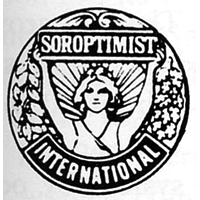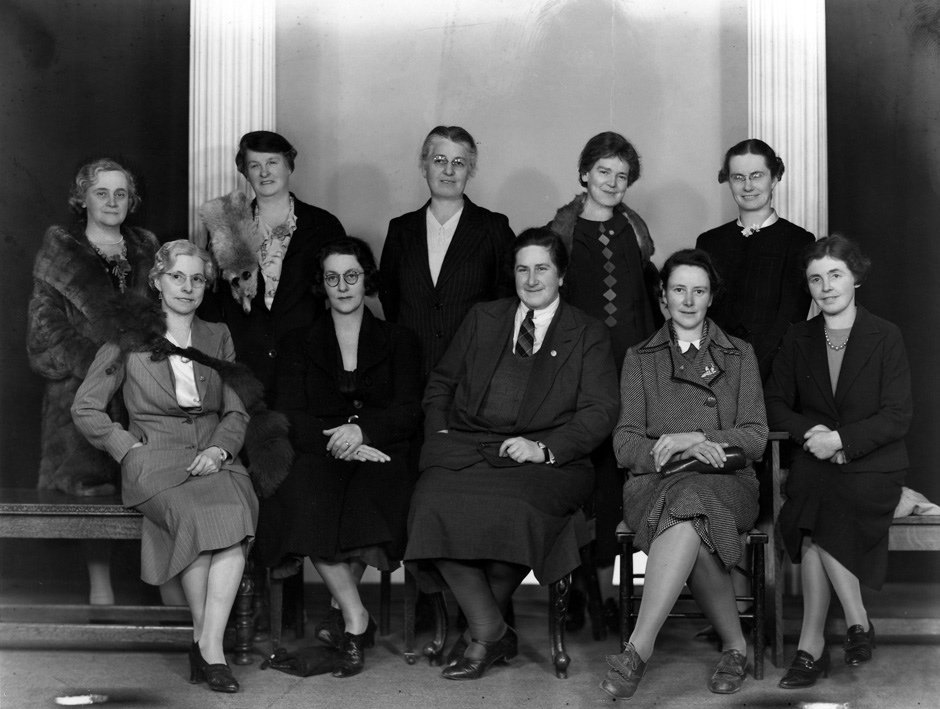
Soroptimist International of Aotearoa New Zealand
1939 –
Theme: Service
Known as:
- Soroptimist International (New Zealand)
1939 – 2018 - Soroptimist International of Aotearoa New Zealand
2018 –
This essay written by Sandy Bardsley was first published in Women Together: a History of Women's Organisations in New Zealand in 1993. It was updated by Yvonne Simpson and Annette Smith in 2018.
1939 – 1993
In 1993 Soroptimist International was one of the world's largest women's service organisations, involving nearly 100,000 women in over 90 countries. The term 'Soroptimist' means 'best of sisters'. The organisation's aims focused on high ethical standards in professional life, advancement of the status of women, international understanding, and community service. It emerged from an amalgamation of British and American women's service organisations in the 1920s, holding its first international meeting in 1928.
New Zealand belonged to the youngest of Soroptimists' four international federations, that of the South West Pacific (SISWP), involving eleven other countries. Federations were divided into regions, of which New Zealand had three – north, central and south – with an average of nine clubs in each. Activities at the club level attracted most members, but the regional, federation and international connections were especially important in fundraising for large-scale projects.
The first Soroptimist club in New Zealand was chartered in Wellington in November 1939. Ten years later clubs were established in Auckland and Christchurch; the first president of the Christchurch club was Hilda Lovell-Smith (known as Kitty), who had been a close friend of Kate Sheppard. Like those in Australia, they were then 'clubs at large', under the Federation of Great Britain and Ireland. After many years of struggling for independence, the Federation of the South West Pacific was formed in 1978. The real growth period for Soroptimist International (New Zealand) (SINZ) came in the 1970s and early 1980s. By 1991 there were 27 clubs in New Zealand and 810 members, about 20 to 25 percent of whom were retired or honorary members.
Membership was originally based on a classification system by occupation, each club having only one member per occupational category. In 1992 this rule was relaxed to allow another woman in the same category to join, three years after the first joined. Membership was by invitation, and an effort was made to attract the most senior woman locally in any one occupation. Because of this, the average age of members was traditionally in the early fifties. Newly chartered clubs had a lower average age.
Soroptimist membership involved commitment on two levels: money and time. By the 1990s, annual subscriptions of around $80–$100 supported the administration of the local club, the region, the federation and the international organisation. Most clubs had dinner meetings once a month, which members paid to attend; they were also expected to give financial support to fundraising activities. Clubs were expected to hold at least fifteen meetings each year, and members pledged to attend at least half, though records showed that attendance had traditionally been a problem in some clubs. Members were also obliged to help with their club's community projects and with fundraising.
Fundraising projects took place at each level of the organisation. International projects were selected every four years: in the early 1990s the project involved working with Sight Savers to provide 'Under Fives' clinics for children in Bangladesh. The Federation of the South West Pacific was also raising $80,000 to endow a chair for research into Alzheimer's disease. The New Zealand regions frequently combined to raise funds for projects, such as Canteen camps (for teenagers with cancer), and scholarships for women. Local clubs chose projects most relevant to their communities. There was an emphasis on giving service and practical support to other women and to children, as well as to disadvantaged groups in the community.
When New Zealand commemorated 100 years of women's suffrage in 1993, SINZ was invited to be part of a committee to celebrate, and placed a pot of daffodils on the steps of Parliament for each of the 21 women MPs.
Sandy Bardsley
1994 – 2018
Soroptimist International (New Zealand) (SINZ) changed its name to Soroptimist International of Aotearoa New Zealand (SIANZ) in 2018. Its members were active at local, national and international level, with projects, advocacy and leadership opportunities to benefit women and girls.
By 2018 Soroptimist clubs were organised in two regions, SI Aotearoa New Zealand North (thirteen clubs with 196 members) and SI Aotearoa New Zealand South (seven clubs with 205 members). The decline in membership numbers since 1993 was of concern, given that there was still such an urgent need to address issues disadvantaging women. Membership criteria had changed in the 1990s from a classified system by occupation to an open system, where importance was placed on willingness to give service, and live the Soroptimist values of high ethical standards and friendship. Both regions had Friendship Grant Visitors – visiting Soroptimists from other countries who shared their experiences. Social media, especially Facebook and websites, was embraced by Soroptimist clubs to connect with other Soroptimists and to promote activities.
Worldwide, in 2018 Soroptimist International (SI) had 75,000 club members in 122 countries/territories. All Soroptimists valued service, high ethical standards, international goodwill, and friendship, and members were welcome to visit any club. All were expected to embrace the SI mission: ‘to transform the lives and status of women and girls through education, empowerment and enabling opportunities’. Soroptimists advocated for equity and equality, the creation of safe and healthy environments, increased access to education, and developing leadership and practical skills for a sustainable future. The international theme for 2018 was ‘Soroptimists Educate to Lead’.
SI had consultative status with the Economic and Social Council (ECOSOC), the UN’s central platform for reflection, debate, and innovative thinking on sustainable development. SI worked together with other non-government organisations (NGOs) and UN agencies in Vienna, Geneva, Rome, New York, and Nairobi, to advocate for change and be a global voice for women and girls.
The SIANZ national president, also known as the national representative, was the spokesperson for the national organisation, and sat on the South West Pacific Federation board as a director. Betty Loughhead had been the first New Zealand Soroptimist to become president of Soroptimist International. She was commemorated by the Betty Loughhead Scholarship, inaugurated in 1986 to support mature women with second chance education. In 2003 a korowai, Māori cloak, named Te Amo Oranga Nui Ki Te Ao, was made by the acclaimed weaver Whero Bailey (Te Atiawa) for the highest ranking member of Soroptimist International (New Zealand) (as it then was) to wear on special occasions, such as university graduation, charter celebrations, marriage, or receiving a civic honour. The cloak included blue and gold feathers, the Soroptimist colours, and was presented to Elaine Moffat of SI Lower Hutt, president of the South West Pacific federation (SISWP), at the federation conference held in Wellington in July 2004.
Other notable Soroptimists stepping up to federation and international leadership posts after 1993 included Anne Farrington of SI North Shore, SI treasurer, and Yvonne Simpson, QSM, of SI Westland, president of SISWP and the second New Zealander to become SI president (2015–2017). In her name, the South Island region funded a member to attend the UN Commission on the Status of Women in New York in 2018; it hoped to continue doing so every two years, with the aim of educating and empowering future SIANZ leaders.
The annual membership subscription in 2018 was around $120. New Zealand clubs met regularly once or twice a month, with each club running the business and social side in ways which best suited their members, and undertaking a programme of service with projects aimed at meeting the SI mission. Most provided at least one annual scholarship towards a girl’s tertiary education. Clubs also supported the SI President’s Appeal. Local club projects raised awareness on issues affecting women, especially domestic violence, gender equality and women’s health, through fundraising activities and with hands-on support. Examples included support for women’s refuges, and providing sanitary items and toiletries for women who had to go to hospital at short notice.
In addition, SIANZ had a national project running for two years, and able to be extended for another two. Twenty-first century projects included working with the Brainwave Trust in raising awareness of how the brain develops; supporting End Child Prostitution and Trafficking (ECPAT); and supporting Te Tonu to help young girls overcome the trauma of sexual abuse.
Yvonne Simpson and Annette Smith
Unpublished sources
Bardsley, Sandy, interview with Janice Macdonald, president of the South West Pacific Federation, 24 May 1992
Johnston, Kristeen, Jane Chapman and Wendy Harland, ‘The History of Soroptimist International of Wellington – 75th Anniversary of the Club’ (booklet), 2014.
Kentish, Gertrude F., 'The Story of Soroptimist International of the South West Pacific for the Golden Jubilee 1937–1987' (pamphlet) [n.d.]
Rippon, Jenny., 50th Jubilee Booklet, SI of Lower Hutt, 2015
SINZ Central records, 1985–, Soroptimist archives, Waitara, NZ
SINZ North records, 1954–1985, AIM
SINZ South records, 1973–1992, Canterbury Public Library
SINZ South Manual of Policy 1973–2018
SINZ of Wellington records 1939–1984, ATL, Wellington
Spears, Sylvia, ‘The Story of Soroptimism in New Zealand 1939–1994’, 1995
Stewart, Elizabeth, ‘History of SI New Zealand South Incorporated’, 1973–1982, 1983
'What is Soroptimist International?' (pamphlet), c.1991
Published sources
Haywood, Janet, The History of Soroptimist International, SI, Cambridge UK, 1995


Community contributions